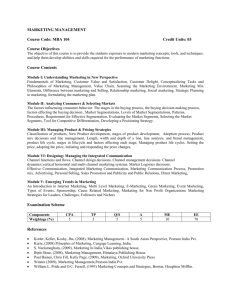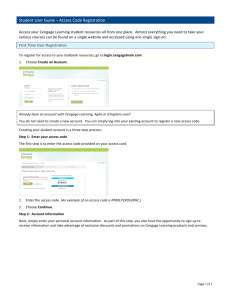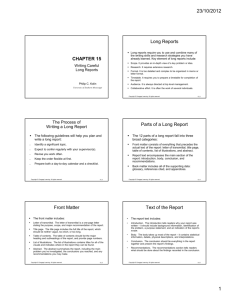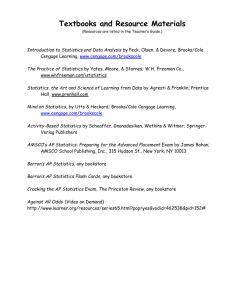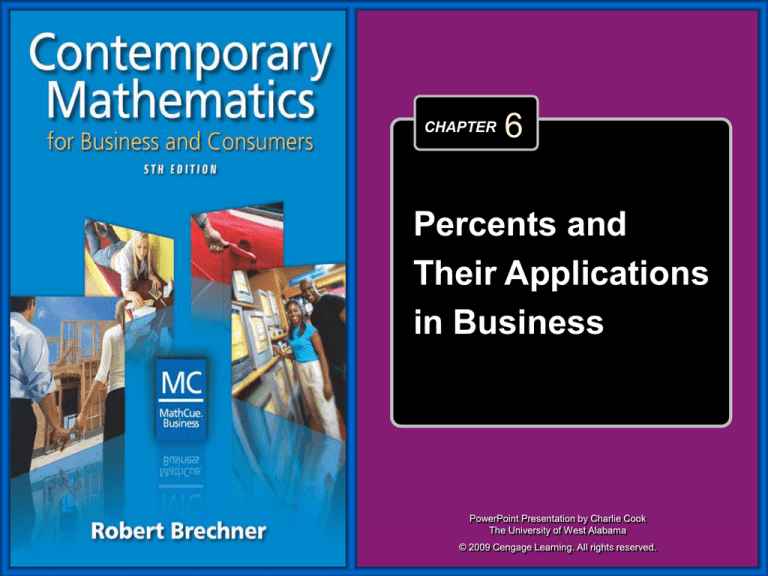
CHAPTER
6
Percents and
Their Applications
in Business
PowerPoint Presentation by Charlie Cook
The University of West Alabama
© 2009 Cengage Learning. All rights reserved.
PERFORMANCE OBJECTIVES
Section I
Understanding and Converting Percents
6-1: Converting percents to decimals and decimals to percents
6-2: Converting percents to fractions and fractions to percents
Section II Using the Percentage Formula to Solve Business
Problems
6-3: Solving for the portion
6-4: Solving for the rate
6-5: Solving for the base
Section III Solving Other Business Problems Involving Percents
6-6: Determining rate of increase or decrease
6-7: Determining amounts in increase or decrease situations
6-8: Understanding and solving problems involving percentage points
© 2009 Cengage Learning. All rights reserved.
6–2
Understanding Equations
Formula
A mathematical representation of a fact, rule, principle, or other logical
relation in which letters represent number quantities.
Equation
A mathematical statement expressing a relationship of equality; usually
written as a series of symbols that are separated into left and right
sides and joined by an equal sign. X + 7 = 10 is an equation.
Expression
A mathematical operation or a quantity stated in symbolic form, not
containing an equal sign. X + 7 is an expression.
Constants
(Knowns)
The parts of an equation that are given. In equations, the knowns are
constants (numbers), which are quantities having a fixed value. In the
equation X + 7 = 10, 7 and 10 are the knowns or constants.
Terms
The knowns (constants) and unknowns (variables) of an equation. In
the equation X + 7 = 10, the terms are X, 7, and 10.
Solve an
Equation
The process of finding the numerical value of the unknown in an
equation.
© 2009 Cengage Learning. All rights reserved.
6–3
Understanding and Converting Percents
• percent
A way of representing the parts of a whole. Percent
means per hundred or parts per hundred.
• percent sign
The symbol, %, used to represent percents. For
example, 1 percent would be written 1%.
© 2009 Cengage Learning. All rights reserved.
6–4
Converting Percents to Decimals
© 2009 Cengage Learning. All rights reserved.
6–5
Converting Percents to Decimals Example
28%
.28
13.4%
.134
6½% = 6.5%
.065
.02%
.0002
© 2009 Cengage Learning. All rights reserved.
6–6
Converting Decimals to Percents
© 2009 Cengage Learning. All rights reserved.
6–7
Converting Decimals to Percents Example
3.5
350%
.34½
.345 = 34.5%
.00935
.935%
5.33
533%
© 2009 Cengage Learning. All rights reserved.
6–8
Converting Percents to Fractions
© 2009 Cengage Learning. All rights reserved.
6–9
Converting Percents to Fractions Example
5
1
5%
100
20
37.5% 37
1
2
1
75
1
75
3
100
2
100
200
8
1
62 % 62
2
1
2
1
125
1
125
5
100
2
100
200
8
8
1
8
1
.8%
10 100
1000
125
© 2009 Cengage Learning. All rights reserved.
6–10
Converting Percents to Fractions Example
(cont’d)
230
230%
2
100
30
100
2
3
10
450
450%
4
100
50
100
4
1
2
8
1
8
1
.8%
10 100
1000
125
© 2009 Cengage Learning. All rights reserved.
6–11
Converting Fractions to Percents
3
.75 75%
4
12
2 52 2.4 240%
5
125
1 14 1.25 125%
100
© 2009 Cengage Learning. All rights reserved.
6–12
Converting Fractions to Percents
3
.75 75%
4
12
2
5
2
5
2.4 240%
125
1
100
1
4
1.25 125%
78
3
24
4
© 2009 Cengage Learning. All rights reserved.
1
5
1
4
3.25 325%
4.2 420%
6–13
Using the Percentage Formula
to Solve Business Problems
• base
The variable of the percentage formula that
represents 100%, or the whole thing.
• portion
The variable of the percentage formula that
represents a part of the base.
• rate
The variable of the percentage formula that defines
how much or what part the portion is of the base. The
rate is the variable with the percent sign.
© 2009 Cengage Learning. All rights reserved.
6–14
Steps for Solving Percentage Problems
© 2009 Cengage Learning. All rights reserved.
6–15
The Magic Triangle
© 2009 Cengage Learning. All rights reserved.
6–16
Sample Percentage Problems
• Maritza Torres owns 37% of a travel agency.
• If the total worth of the business is $160,000,
how much is Maritza’s share?
P R B .37 160,000 59,200
© 2009 Cengage Learning. All rights reserved.
6–17
Sample Percentage Problems (cont’d)
• What is the sales tax in a state where the tax on
a purchase of $464 is $25.52?
P
25.52
R
.055 5.5%
B
464
© 2009 Cengage Learning. All rights reserved.
6–18
Sample Percentage Problems (cont’d)
• The Daily Times reports that 28% of its advertising is for
department stores.
• If the department store advertising amounts to $46,200,
what is the total advertising revenue of the newspaper?
P 46,220
B
165,000
R
.28
© 2009 Cengage Learning. All rights reserved.
6–19
Sample Percentage Problems (cont’d)
• Lisa Walden, a sales associate for a large company,
successfully makes the sale on 40% of her sales
presentations.
• If she made 25 presentations last week, how many sales
did she make?
P R B .4 25 10
© 2009 Cengage Learning. All rights reserved.
6–20
Sample Percentage Problems (cont’d)
• A quality control process finds 17.2 defects for
every 8,600 units of production.
• What percent of the production is defective?
P
17.2
R
.002 0.2%
B
8,600
© 2009 Cengage Learning. All rights reserved.
6–21
Sample Percentage Problems (cont’d)
• The Bentley Bobcats have won 80% of their
basketball games. If they lost 4 games, how
many games have been played?
Won = 80%
Lost = 20%
P
4
B
20
R
.2
© 2009 Cengage Learning. All rights reserved.
6–22
Determining Rate of Increase or Decrease
Amount of change
Rate of Change
Original amount
© 2009 Cengage Learning. All rights reserved.
6–23
Rate of Increase or Decrease Example
• Allied Plumbing sold 2,390 feet of 5/8-inch galvanized
pipe in July. If 2,558 feet were sold in August, what is
the percent increase in pipe footage sales?
P Increase 2,558 2,390 168
B Original Amount 2,390
P
168
R
.07 7%
B
2,390
© 2009 Cengage Learning. All rights reserved.
6–24
Rate of Increase or Decrease Example
• The supermarket price of yellow onions dropped from
$.59 per pound to $.45 per pound. What is the percent
decrease in the price of onions?
P Decrease $0.59 $0.49 $0.14
B Original Amount $0.59
P .14
R
.2373 23.73%
B .59
© 2009 Cengage Learning. All rights reserved.
6–25
Determining the New Amount
After a Percent Change
© 2009 Cengage Learning. All rights reserved.
6–26
Determining the New Amount After
a Percent Change Example
• Economists predict that next year housing prices
will drop by 4%. This year’s price for an average
house is $110,000. What will the average price
of a house be next year?
Rate 100% 4% 96%
Base Original Amount 110,000
P R B .96 110,000 105,600
© 2009 Cengage Learning. All rights reserved.
6–27
Determining the Original Amount
Before a Percent Change
© 2009 Cengage Learning. All rights reserved.
6–28
Determining the Original Amount
Before a Percent Change Example
• Metro Motors sold 112 cars this month. If this is
40% better than last month, how many cars
were sold last month?
Portion 112
Rate 100% 40% 140% 1.4
P
112
B
80 cars
R
1.4
© 2009 Cengage Learning. All rights reserved.
6–29
Determining the Original Amount Before
a Percent Change Example (cont’d)
• The second shift of a factory produced 17,010
units. If this amount was 5 ½% less than the
first shift, how many units were produced on the
first shift?
Portion 17,010
Rate 100% 5
1
2
% 94 12 0% .945
P
17,010
B
18,000 units
R
.945
© 2009 Cengage Learning. All rights reserved.
6–30
Problems Involving Percentage Points
• percentage points
A way of expressing a change from an original
amount to a new amount, without using a percent
sign.
Change in percentage points
Rate of
=
change
Original amount of percentage points
© 2009 Cengage Learning. All rights reserved.
6–31
Problems Involving Percentage Points
• After a vigorous promotion campaign, HiLo Mart
increased its market share from 5.4% to 8.1%, a
rise of 2.7 percentage points. What percent
increase in sales does this represent?
Portion Increase 2.7% .027
Base 5.4% .054
P
.027
Rate of change
.5 50%
B
.054
© 2009 Cengage Learning. All rights reserved.
6–32
Problems Involving Percentage Points
• The unemployment rate in Glen Haven dropped
from 8.8% to 6.8% in the past year, a decrease
of 2 percentage points. What percent decrease
does this represent?
Portion Decrease 2.0% .020
Base 8.8% .088
P .020
Rate of change
.2273 22.73%
B .088
© 2009 Cengage Learning. All rights reserved.
6–33
Chapter Review Problem 1
• Solve the following by converting to a decimal:
27%
.27
.81%
.0081
12 34 %
12.75% .1275
23
5
%
© 2009 Cengage Learning. All rights reserved.
4 53 % 4.6% .0046
6–34
Chapter Review Problem 2
• An ad read, “This week only, all merchandise
35% off!” If a television set normally sells for
$349.95, what is the amount of the savings?
Rate 35%
Base Original Amount 349.95
P R B .35 349.95 122.48
© 2009 Cengage Learning. All rights reserved.
6–35
Chapter Review Problem 3
• If 453 runners out of 620 completed a marathon,
what percent of the runners finished the race?
Portion 453
Base Original Amount 620
P
453
R
.731 73.1%
B
620
© 2009 Cengage Learning. All rights reserved.
6–36
Chapter Review Problem 4
• By what percent is a 100-watt light bulb brighter
than a 60-watt bulb?
Portion Increase 100 60 40
Base Original Amount 60
P
40
R
.667 66.7%
B
60
© 2009 Cengage Learning. All rights reserved.
6–37
Chapter Review Problem 5
• A pre-election survey shows that the popularity
of a presidential candidate has increased from
26.5 percent to 31.3 percent of the electorate,
an increase of 4.8 percentage points. What
percent increase does this represent?
Portion Increase 31.3 26.5 4.8
Base Original Amount 26.5
P
4.8
R
.181 18.1%
B
26.5
© 2009 Cengage Learning. All rights reserved.
6–38

